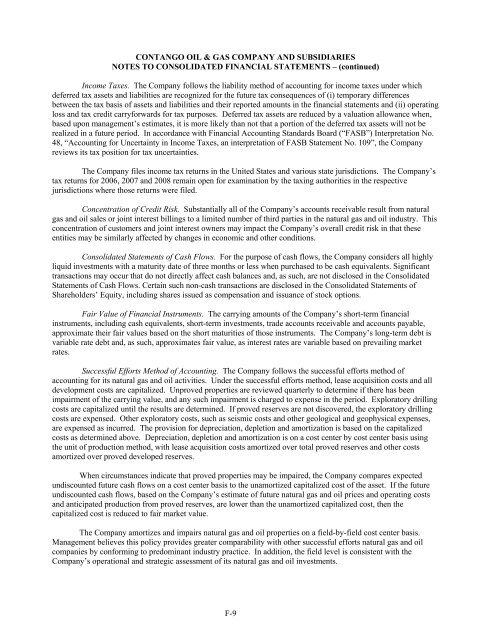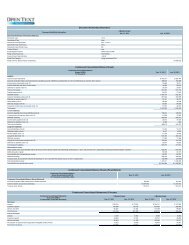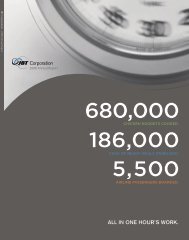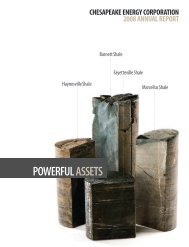FORM 10-K CONTANGO OIL & GAS COMPANY
FORM 10-K CONTANGO OIL & GAS COMPANY
FORM 10-K CONTANGO OIL & GAS COMPANY
You also want an ePaper? Increase the reach of your titles
YUMPU automatically turns print PDFs into web optimized ePapers that Google loves.
<strong>CONTANGO</strong> <strong>OIL</strong> & <strong>GAS</strong> <strong>COMPANY</strong> AND SUBSIDIARIES<br />
NOTES TO CONSOLIDATED FINANCIAL STATEMENTS – (continued)<br />
Income Taxes. The Company follows the liability method of accounting for income taxes under which<br />
deferred tax assets and liabilities are recognized for the future tax consequences of (i) temporary differences<br />
between the tax basis of assets and liabilities and their reported amounts in the financial statements and (ii) operating<br />
loss and tax credit carryforwards for tax purposes. Deferred tax assets are reduced by a valuation allowance when,<br />
based upon management’s estimates, it is more likely than not that a portion of the deferred tax assets will not be<br />
realized in a future period. In accordance with Financial Accounting Standards Board (“FASB”) Interpretation No.<br />
48, “Accounting for Uncertainty in Income Taxes, an interpretation of FASB Statement No. <strong>10</strong>9”, the Company<br />
reviews its tax position for tax uncertainties.<br />
The Company files income tax returns in the United States and various state jurisdictions. The Company’s<br />
tax returns for 2006, 2007 and 2008 remain open for examination by the taxing authorities in the respective<br />
jurisdictions where those returns were filed.<br />
Concentration of Credit Risk. Substantially all of the Company’s accounts receivable result from natural<br />
gas and oil sales or joint interest billings to a limited number of third parties in the natural gas and oil industry. This<br />
concentration of customers and joint interest owners may impact the Company’s overall credit risk in that these<br />
entities may be similarly affected by changes in economic and other conditions.<br />
Consolidated Statements of Cash Flows. For the purpose of cash flows, the Company considers all highly<br />
liquid investments with a maturity date of three months or less when purchased to be cash equivalents. Significant<br />
transactions may occur that do not directly affect cash balances and, as such, are not disclosed in the Consolidated<br />
Statements of Cash Flows. Certain such non-cash transactions are disclosed in the Consolidated Statements of<br />
Shareholders’ Equity, including shares issued as compensation and issuance of stock options.<br />
Fair Value of Financial Instruments. The carrying amounts of the Company’s short-term financial<br />
instruments, including cash equivalents, short-term investments, trade accounts receivable and accounts payable,<br />
approximate their fair values based on the short maturities of those instruments. The Company’s long-term debt is<br />
variable rate debt and, as such, approximates fair value, as interest rates are variable based on prevailing market<br />
rates.<br />
Successful Efforts Method of Accounting. The Company follows the successful efforts method of<br />
accounting for its natural gas and oil activities. Under the successful efforts method, lease acquisition costs and all<br />
development costs are capitalized. Unproved properties are reviewed quarterly to determine if there has been<br />
impairment of the carrying value, and any such impairment is charged to expense in the period. Exploratory drilling<br />
costs are capitalized until the results are determined. If proved reserves are not discovered, the exploratory drilling<br />
costs are expensed. Other exploratory costs, such as seismic costs and other geological and geophysical expenses,<br />
are expensed as incurred. The provision for depreciation, depletion and amortization is based on the capitalized<br />
costs as determined above. Depreciation, depletion and amortization is on a cost center by cost center basis using<br />
the unit of production method, with lease acquisition costs amortized over total proved reserves and other costs<br />
amortized over proved developed reserves.<br />
When circumstances indicate that proved properties may be impaired, the Company compares expected<br />
undiscounted future cash flows on a cost center basis to the unamortized capitalized cost of the asset. If the future<br />
undiscounted cash flows, based on the Company’s estimate of future natural gas and oil prices and operating costs<br />
and anticipated production from proved reserves, are lower than the unamortized capitalized cost, then the<br />
capitalized cost is reduced to fair market value.<br />
The Company amortizes and impairs natural gas and oil properties on a field-by-field cost center basis.<br />
Management believes this policy provides greater comparability with other successful efforts natural gas and oil<br />
companies by conforming to predominant industry practice. In addition, the field level is consistent with the<br />
Company’s operational and strategic assessment of its natural gas and oil investments.<br />
DB2/2<strong>10</strong>43537.7 F-9










